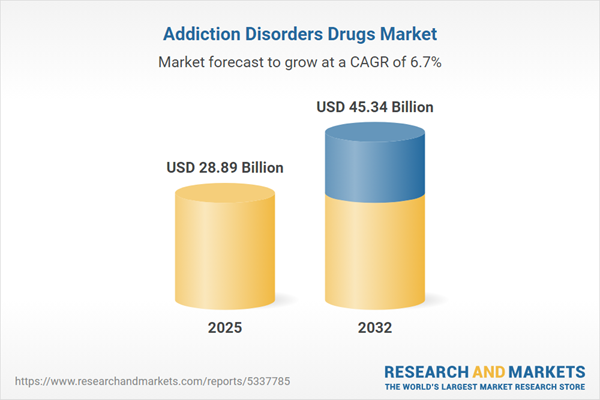Speak directly to the analyst to clarify any post sales queries you may have.
Senior leaders face significant complexity in the addiction disorders drugs market, where regulatory shifts, digital innovation, and new care delivery models demand agile strategy development and informed decision-making. Navigating this landscape requires clarity on market forces, real-time trends, and the competitive environment.
Market Snapshot: Current Trends and Growth Drivers in the Addiction Disorders Drugs Market
The addiction disorders drugs market is valued at USD 27.08 billion and is expected to reach USD 45.34 billion by 2032, with a projected CAGR of 6.65%. Market expansion is fueled by advancements in therapeutic options, increased investment in digital health technologies, and a growing focus on patient-centered care models. Healthcare organizations are modernizing supply chain processes, applying real-time analytics, and strengthening digital engagement initiatives to remain compliant and responsive to shifting industry requirements. These elements collectively drive a strategic emphasis on operational precision, patient outcomes, and the need for adaptable business models to address ongoing changes across care and regulatory landscapes.
Scope & Segmentation: Strategic Overview for Decision-Makers
- Product Types: Branded formulations and generics expand pricing options and unlock new market access approaches targeting specific payers and patient segments.
- Dosage Forms: Capsules, films, injectables, patches, and tablets address diverse patient preferences and foster widespread treatment adoption across various geographies.
- Administration Routes: Oral, injectable, sublingual, and transdermal options enable flexible care pathways and support both acute intervention and maintenance therapies.
- Drug Classes: Key active agents—acamprosate, disulfiram, naltrexone, bupropion, nicotine replacement therapies, varenicline, buprenorphine, and methadone—are essential for tailored treatment strategies that align with distinct substance use disorders.
- Distribution Channels: Hospital, retail, and online pharmacies ensure broad product availability, driving patient access and supporting ongoing adherence programs in multiple care settings.
- End Users: Hospitals, clinics, and homecare providers deliver therapy in both institutional and community environments, improving accessibility and continuity of care.
- Geographic Regions: Market coverage spans the Americas, EMEA, and Asia-Pacific, with strategic focus on the United States, United Kingdom, Germany, France, China, India, and Australia. Each region presents unique regulatory considerations and operational challenges impacting strategy and execution.
- Company Coverage: Competitive benchmarking includes leading manufacturers such as Pfizer Inc., Johnson & Johnson, Indivior plc, Alkermes plc, Camurus AB, Orexo AB, BioDelivery Sciences International, Inc., Titan Pharmaceuticals, Inc., Mallinckrodt plc, and Teva Pharmaceutical Industries Ltd. Company positioning reveals evolving innovation paths and differentiation within established and emerging markets.
Key Takeaways for Senior Leaders
- Aligning digital health platforms with patient pathways enables efficient care coordination, greater engagement, and improved continuity from diagnosis through ongoing support.
- Strategic partnerships accelerate treatment innovation, enhance distribution capabilities, and ensure compliance with increasingly intricate regulatory requirements across global markets.
- Broadening product portfolios serves as a vital response to fluctuating payer demands and evolving treatment paradigms, promoting sustainable market presence and organizational agility.
- Understanding local regulatory dynamics enhances market entry and risk management, a crucial factor for navigating operational complexity in diverse regions.
- Integrating digital and specialty pharmacy models enables patient-centric approaches, drives adherence, and supports robust outcomes throughout the recovery journey.
Tariff Impact: Effects on Supply Chain and Pricing
Recent updates to U.S. tariff policy are influencing ingredient costs for addiction disorder drugs. As a result, manufacturers are refining sourcing models and adjusting production strategies. These changes prompt capital reallocation across operations and necessitate agile purchasing approaches that can absorb shifting cost structures. Downstream, pharmacies and retailers are implementing scenario-based planning, renegotiating supplier contracts, and proactively managing inventory to stabilize profitability and maintain reliable therapy delivery despite potential supply volatility.
Methodology & Data Sources
This research relies on primary interviews with sector stakeholders, comprehensive industry-wide surveys, and critical analysis of peer-reviewed literature, regulatory filings, and operational disclosures. Independent experts validate all key findings, enabling a dynamic and accurate portrayal of sector trends and market shifts.
Why This Report Matters
- Provides actionable insights to help leadership teams align product development and digital transformation with evolving regulations and innovative addiction care models.
- Equips executives with scenario planning tools for effective risk management across supply chain, pricing, and compliance challenges in a rapidly changing environment.
- Supports data-driven investment and collaboration strategies, empowering organizations to enhance digital health performance and strengthen payer relationships.
Conclusion
This analysis empowers decision-makers to address market complexities, drive sustainable innovation, and enhance organizational resilience in the evolving addiction disorders drugs sector.
Additional Product Information:
- Purchase of this report includes 1 year online access with quarterly updates.
- This report can be updated on request. Please contact our Customer Experience team using the Ask a Question widget on our website.
Table of Contents
3. Executive Summary
4. Market Overview
7. Cumulative Impact of Artificial Intelligence 2025
Companies Mentioned
The companies profiled in this Addiction Disorders Drugs market report include:- Pfizer Inc.
- Johnson & Johnson
- Indivior plc
- Alkermes plc
- Camurus AB
- Orexo AB
- BioDelivery Sciences International, Inc.
- Titan Pharmaceuticals, Inc.
- Mallinckrodt plc
- Teva Pharmaceutical Industries Ltd.
Table Information
| Report Attribute | Details |
|---|---|
| No. of Pages | 198 |
| Published | October 2025 |
| Forecast Period | 2025 - 2032 |
| Estimated Market Value ( USD | $ 28.89 Billion |
| Forecasted Market Value ( USD | $ 45.34 Billion |
| Compound Annual Growth Rate | 6.6% |
| Regions Covered | Global |
| No. of Companies Mentioned | 11 |









